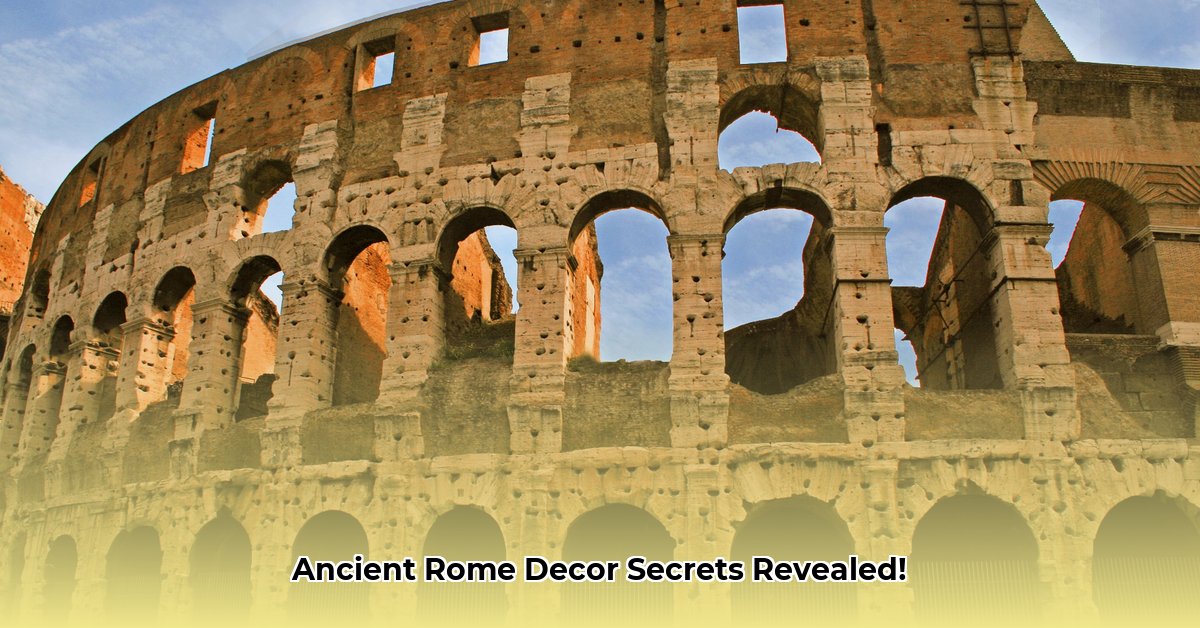Step into the opulent world of ancient Rome, not through the dust of gladiatorial arenas, but within the intimate grandeur of private dwellings. Beyond the marble facades, Roman homes were meticulously curated spaces, reflecting power, wealth, and a surprising dedication to comfort—a concept often misunderstood in antiquity. The furniture and decor Romans chose reveal a rich narrative about their daily lives, their values, and their innovative spirit, offering boundless inspiration for contemporary interior design. Learn more about Roman furniture and its influence on modern design.
By delving into the surviving remnants and literary accounts, we unearth design secrets that remain remarkably relevant today, proving that true elegance transcends millennia.
The Blueprint of Roman Interiors: Beyond Mere Walls
Our understanding of Roman interior design stems from a blend of literary sources—such as Pliny’s Natural History and Suetonius’s Histories—and invaluable archaeological discoveries. The volcanic ash of Mount Vesuvius, in its devastating eruption in 79 A.D., paradoxically preserved an unparalleled snapshot of Roman life in Pompeii and Herculaneum. These sites, along with others like the Golden House of Nero, have unveiled the intricate details of homes long buried, challenging modern misconceptions about their aesthetic.
Far from being stark and unadorned, Roman interiors were vibrant canvases. Walls, often plastered, were painted to mimic costly marble veneers or adorned with intricate frescoes depicting columns, elaborate imaginary views, and figures. Rich color also emanated from superbly executed mosaic floors, elegant couches with vibrant cushions, and sophisticated bronze lamps, creating a cohesive and immersive living experience.
Core Pillars of Roman Furniture: Function, Form, and Status
The fundamental pieces of Roman furniture were few, yet each served a multifaceted role, balancing practical utility with profound social symbolism. Roman design, heavily influenced by earlier Greek aesthetics, prioritized durability, elegance, and a clear reflection of social standing.
Lecti (Beds and Couches): The Heart of the Roman Home
The lectus (plural lecti) was arguably the most significant piece of furniture in a Roman household, serving far more than its primary function as a bed. It was a versatile centerpiece for sleeping, dining, reading, writing, and receiving guests.
- Lectus Cubicularis: This was the traditional bed for sleeping, typically found in the cubiculum (bedroom). Crafted from wood like oak, maple, or cedar, these beds often had frames adorned with bronze, silver, gold, ivory, or tortoise-shell inlay for the wealthy. Mattresses, known as torus, were stuffed with materials ranging from straw or reeds for the poor, to fine wool from Leuconian flocks or even swan’s down for the elite, as described by Pliny. They were topped with multiple coverings, including counterpanes (lodices) and richly colored damask quilts (polymitum).
- Lectus Triclinaris: In the triclinium (dining room), specialised lecti were arranged for diners to recline comfortably, a hallmark of elite Roman banquets. These couches, often accommodating three people, facilitated conversation and social interaction during meals.
- Lectus Lucubratorius: A specific type of couch designed for study and contemplation, allowing individuals to recline while reading or writing during the day.
- Ritualistic Lecti: Beds also played roles in significant social and religious ceremonies, such as the lectus genialis associated with marriage, or the lectus funebris, a bier used to display the deceased during funeral rites.
Archaeological Insights: Beds Unveiled
Recent discoveries continue to illuminate the diversity and significance of Roman beds. In February 2024, archaeologists in London unearthed a remarkably intact 2,000-year-old Roman funerary bed made of carved oak, found alongside five oak coffins. This marks the first complete funerary bed found in Britain, suggesting it was used to transport the deceased and served as a grave good for the afterlife.
Near Kozani, northern Greece, a first-century B.C. burial revealed a woman on a bronze “mermaid bed,” adorned with mythical depictions and a bird holding a snake—a symbol of Apollo. Though its wooden components had decomposed, the bronze frame offered a unique glimpse into funerary customs and artistic expression. In Pompeii, archaeologists found the charred remains of a bed, its outline seared into the walls, suggesting a lamp was knocked over during the eruption’s initial panic.
Mensae (Tables): The Canvas for Display
Mensae (the Latin word for tables) were indispensable throughout the Roman home, serving practical needs and acting as prominent displays of wealth. They varied immensely in form and construction, reflecting the owner’s status.
- Materials and Craftsmanship: While simple wooden tables served everyday purposes, the most prized were round tables crafted from cross-sections of the citrus tree (
citrus mensae). Valued for their beautifully marked, undulating grain, these could fetch astronomical prices; Cicero reportedly paid $20,000, and one family, the Cethegi, owned a table valued at $60,000. Other luxurious tables featured bronze frames inlaid with silver and niello, marble tops, or veneers of exotic woods, ivory, and tortoise-shell. - Forms and Functions:
- Monopodium: A table or stand with a single support, often used in bedrooms to hold lamps or toilet articles.
Abacus: A rectangular table with a raised rim, serving as a sideboard for plates and dishes.
Delphica: A three-legged table. - Many tables featured adjustable legs, while permanent dining tables in triclinia were often solid masonry or concrete with polished stone or mosaic tops.
- Monopodium: A table or stand with a single support, often used in bedrooms to hold lamps or toilet articles.
Sellae (Chairs and Seats): Symbols of Authority
The category of sellae encompassed a wide array of seating options, from simple stools to highly symbolic chairs that denoted immense power.
- Sella: The most common seat for one person, a simple stool without arms or a back, used by men, women, children, and slaves for various tasks and meals.
- Subsellium: A bench, differing from the stool only in its ability to accommodate multiple persons, used in public spaces like the Curia (Senate house) and schools, as well as private homes.
- Sella Curulis: Distinctively characterized by its X-shaped, foldable frame, often crafted from ivory or metal. This chair was strictly reserved for high-ranking magistrates and officers, unequivocally symbolizing their political and military authority. Julius Caesar, for instance, had one made of gold.
- Solium: A stiff, dignified, high-backed armchair with solid arms. Often associated with gods and kings, it was typically kept in the atrium for the patron to receive clients, emphasizing his elevated status. A footstool was usually necessary due to its height.
- Cathedra: A chair without arms but with a curved, often sloping back. Initially associated with women due to its perceived luxury, it later gained general use. Its prominence among teachers in Schools of Rhetoric gave rise to the expression ex cathedra, referring to authoritative pronouncements, and its use by bishops explains our modern word “cathedral.”
These chairs, while not typically upholstered, were made comfortable with plentiful cushions and coverings of fine fabrics, providing further opportunities for artistic workmanship and lavish decoration.
Arcae and Armaria (Chests and Cabinets): Guardians of Wealth and Knowledge
These storage solutions were essential for maintaining an organized Roman household and could themselves be symbols of status.
- Arcae: Chests of various sizes, primarily for storing clothes, linen, and securing valuables like papers, money, and jewelry. Usually made of wood, they were often reinforced with iron bindings and ornate bronze hinges and locks. Smaller arcae, akin to jewel cases, could be crafted from silver or even gold. The most important was the strongbox, kept in the tablinum (master’s study), made robustly to deter forced entry and too heavy to be easily removed. Some were even chained to the floor as an additional precaution.
- Armaria: Cabinets designed for similar storage purposes, often divided into compartments and secured with hinges and locks. They were used in libraries to protect scrolls from mice and men, and in the alae (wing-like recesses of the atrium) to display imagines, or wax death masks of ancestors. Unlike modern cabinets, they lacked glass doors but were still highly decorative.
Illuminating Roman Life: Lighting and Timekeeping
Beyond the main furniture pieces, Roman interiors incorporated functional objects that were often transformed into works of art.
Lucernae and Candelabra (Lamps and Stands)
Lighting in Roman homes was provided by lucernae (oil lamps) or candelae (candles).
- Lucernae: Typically simple vessels holding olive oil or melted grease with a wick, but often crafted into exceedingly beautiful forms from terracotta or bronze. They produced a dim, unsteady light without glass chimneys.
- Candelabra: Tall, elegant stands, similar to modern floor lamps, that originally held wax or tallow candles. In wealthier homes, however, oil lamps supplanted candles, suggesting a lack of Roman skill in candle-making despite their earlier appearance in the first century A.D. Some candelabra were adjustable in height, while others supported multiple lamps.
Timekeeping Devices
While sundials (solaria) were common in public spaces from the 2nd century B.C. (and even in miniature pocket versions), wealthy Roman homes increasingly featured sophisticated water-clocks (clepsydrae) from the time of Augustus, demonstrating ingenuity in their construction and accessories.
The Embellished Canvas: Beyond Wooden Frames
Roman interiors were never just about the furniture. They were a holistic design experience where every element contributed to the overall aesthetic and atmosphere.
Wall Decorations
Wall paintings, especially evident in Pompeii and Herculaneum, transformed interior spaces. Dating from about 150 B.C., plastered walls were painted to imitate masonry or, later, depicted elaborate imaginary views, architectural fantasies (like painted ruins in the Villa of Livia), and mythological scenes. Rich colors—yellow, black, magenta, and especially Pompeiian red—were common. In luxurious interiors, brick walls were faced with polished slabs of white and colored stone, or even exotic materials like dark green obsidian and copper-green malachite.
Floor Mosaics
Superbly executed mosaic floors, composed of small fragments (tesserae) of colored stones or glass (often backed with gold foil), provided pictorial decoration. Subjects were diverse, sometimes even depicting simulated food fragments in dining rooms, as if they had dropped from the table—a playful, hyper-realistic touch.
Textiles and Soft Furnishings
Textiles played an immense role, adding color, warmth, and luxury. Richly dyed fabrics, often imported from Egypt or the Near East, were used for cushions, throws, and magnificent wall hangings or tapestries. The richest carpets, from Pergamos in Asia Minor, were so highly valued they were sometimes woven with gold and silver thread. These textiles softened the austerity of stone and brick, transforming houses into vibrant, comfortable homes.
Statuary and Decorative Objects
Interiors were further enriched with a vast array of bronze and marble statuary, often looted from Greece. Buffets displayed enormous quantities of silver platters and hollowware, frequently decorated with intricate repoussé ornament. Mirrors were typically polished bronze or silver. Pottery, while not a luxury item for the wealthy, included finely crafted Samian ware and elaborate imitations of Greek vases.
Archaeological Revelations: Unveiling the Unseen
Modern archaeology continues to shed light on surprising aspects of Roman home life, challenging long-held assumptions.
Roman Refrigerators and Ice Houses:
Much like today, Romans sought ways to keep food cool. Excavations at Novae, a Roman frontier fortress in Bulgaria, revealed small ceramic-tile food storage units in barracks. These “fridges” contained animal bones, dish fragments, and traces of cooked meat, along with small bone “censers” for insect repellent. Another fridge found in Novae still contained a meal, including wine drinking vessels. These discoveries are rare, as they seldom survive building reconstructions.
Near Basel, Switzerland, archaeologists are investigating four-meter-deep shafts at the Roman Augusta Raurica site from 2013, believed to be ancient refrigerators. These shafts were filled with snow and ice in winter, then covered with straw to maintain cool temperatures well into summer, preserving items from cheese and wine to oysters. Experiments attempting to recreate these ancient cool boxes have shown that by gradually filling the shafts with compacted snow and ice blocks, temperatures could remain below freezing until June, demonstrating the feasibility of this ingenious ancient cooling method.
Timeless Echoes: Crafting Roman Elegance for Modern Homes
The enduring principles guiding ancient Roman interior design continue to offer valuable lessons for contemporary aesthetics. How can we draw inspiration from these historical designs and infuse a touch of timeless Roman elegance into our modern living spaces?
- Embrace Classical Proportions and Clean Lines: Roman architecture and design emphasized mathematical proportion and harmonious balance. Apply this by choosing furniture with clean, architectural lines. Focus on creating a sense of order and symmetry in your room layouts, allowing space to breathe as the Romans did by avoiding clutter.
- Luxurious Materials, Understated Palettes: While Romans used vibrant colors on walls, their furniture often showcased the natural beauty of materials. Integrate natural stone (marble, travertine), solid wood, and metals (bronze, brass) in their purest forms. For textiles, opt for rich textures in muted tones or classic patterns to create a sense of quiet luxury, allowing the quality of materials to speak for themselves.
- Strategic Use of Decorative Motifs: Incorporate classical Roman motifs subtly. Think of laurel leaves, acanthus scrolls, or geometric patterns (stripes, squares, diamonds) in fabric prints, decorative moldings, tile work, or even framed art. These elements provide a sophisticated nod to antiquity without overwhelming a modern aesthetic.
- Prioritize Quality Craftsmanship and Longevity: Roman furniture was built to endure. When selecting pieces, invest in items that emphasize durable materials and meticulous attention to detail. This commitment to lasting beauty and functionality aligns with the Roman ethos of creating pieces that stood the test of time.
- Multi-Functional Pieces and Thoughtful Placement: The Romans valued practicality. Their lecti served multiple purposes, and furniture placement was strategic. Choose multi-purpose furniture today (e.g., storage ottomans, sofa beds, nesting tables) and consider how each piece enhances both functionality and the flow of your space, mirroring the intentionality of Roman domestic life.
| Roman Design Principle | Modern Application | Impact on Modern Space |
|---|---|---|
| Classical Proportions | Furniture with balanced dimensions, symmetrical room layouts | Creates harmony, visual calm, and a sense of order |
| Natural Stone & Wood | Marble countertops, solid oak tables, natural fiber rugs | Adds timeless elegance, durability, and texture |
| Subtle Motifs | Laurel wreath patterns on textiles, geometric tile work, carved details | Infuses historical depth without being overtly themed |
| Emphasis on Craftsmanship | Invest in high-quality, artisan-made furniture, bespoke joinery | Enhances longevity, unique character, and perceived value |
| Multi-functional Furniture | Daybeds, storage benches, modular seating, nesting tables | Optimizes space, enhances efficiency, promotes flexible living |
In conclusion, ancient Roman furniture and interior design, though seemingly simple in their core forms, eloquently reflect the values and priorities of a complex and sophisticated civilization. From the multi-functional lectus to the symbolic curule seat, and from the grandeur of painted walls to the surprising innovation of ice-filled shafts, each element tells a powerful story about wealth, status, and daily life. By appreciating the materials, craftsmanship, and strategic placement of these historical furnishings, we gain not only a deeper insight into this ancient culture but also a wealth of design inspiration for our own modern homes. The Roman knack for elegant simplicity and enduring quality truly continues to inspire, proving that good design is indeed timeless.










